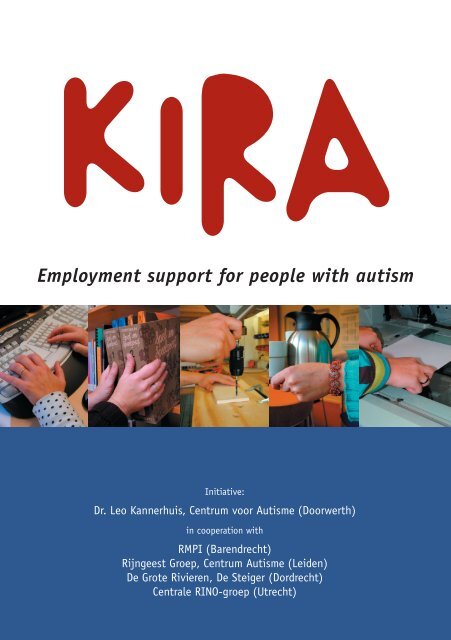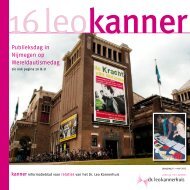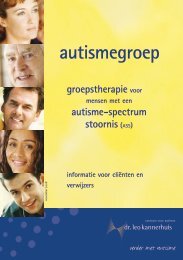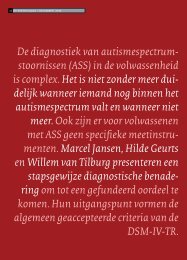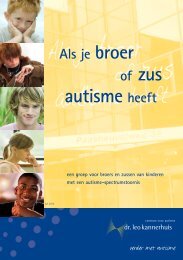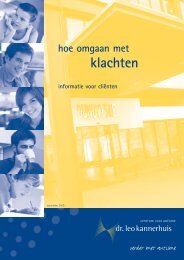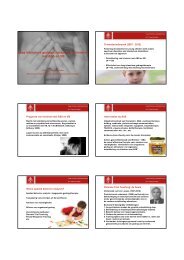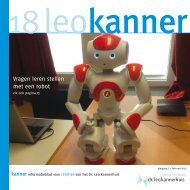here - Dr. Leo Kannerhuis
here - Dr. Leo Kannerhuis
here - Dr. Leo Kannerhuis
- No tags were found...
You also want an ePaper? Increase the reach of your titles
YUMPU automatically turns print PDFs into web optimized ePapers that Google loves.
Employment support for people with autism1Initiative:<strong>Dr</strong>. <strong>Leo</strong> <strong>Kannerhuis</strong>, Centrum voor Autisme (Doorwerth)in cooperation withRMPI (Barendrecht)Rijngeest Groep, Centrum Autisme (Leiden)De Grote Rivieren, De Steiger (Dordrecht)Centrale RINO-groep (Utrecht)
EditorA.A. van Dijk en D.A. Rodenburg<strong>Dr</strong>. <strong>Leo</strong> <strong>Kannerhuis</strong>, Centrum voor Autismeassisted by employees of the following organizations:<strong>Dr</strong>. <strong>Leo</strong> <strong>Kannerhuis</strong>, Centrum voor Autisme (Doorwerth)RMPI (Barendrecht)Rijngeest Groep, Centrum Autisme (Leiden)De Grote Rivieren, De Steiger (Dordrecht)Centrale RINO-groep (Utrecht)PublisherHRmediawww.hrmedia.nlToernooiveld 300 a6525 EC Nijmegen024 - 350 31 76DesignStudio Gerton Hermers, Heumenwww.gertonhermers.nlPhotography (cover)M. Steverink<strong>Dr</strong>. <strong>Leo</strong> <strong>Kannerhuis</strong>, Centrum voor Autisme (Doorwerth)2
ContentPrefaceMethod Introduction1.1 Core concepts1.2 Employment support stages1.2.1 Intake1.2.2 Assessment and orientation1.2.3 Support1.2.4 Coaching and aftercare1.3 Players and elements involved in the method1.3.1 Players1.3.2 Method elements‘What to do’‘How to proceed’1.4 Procedure matrix45577810111212131315203
PrefacePeople with autism are entitled to employment opportunities specifically adaptedto their abilities. The run-up to this kind of employment opportunity is not withoutproblems. Reintegration is problematic and very little support is available in orderto maintain the workplace. The KIRA project provides an operating method w<strong>here</strong>byopportunities are created for people with autism to enter the employment marketand make a motivated contribution to the labour process.The KIRA method has been written for people working in the employment supportfield. Elements from existing employment support methods have been used as astarting point in support of day-to-day practice and, w<strong>here</strong> necessary, adapted tothe target group. This scheme has been generated with financial assistance from theESF-EQUAL fund of the European Union. Various institutions and their employeeshave contributed their time, know how, work experience and mutual exchanges. Thefollowing institutions, all based in the Netherlands, were actively involved:– <strong>Dr</strong>. <strong>Leo</strong> <strong>Kannerhuis</strong>, Centre for Autism, Doorwerth– De Grote Rivieren, ‘De Steiger’ Department, Dordrecht– RMPI, Barendrecht– Rijngeest Group, Autism Centre, Leiden– Central RINO Group, UtrechtThe following text is a summary of the method content developed during theproject. What are the basic principles of this method and who plays an importantpart? The various components of the support process are detailed in stages. Theoperating matrix in this website is of particular importance. The matrix is thebasis of the method, w<strong>here</strong>by background information and ready to use forms forthe support process are easily accessible to the implementing job coach/ projectcounsellor of a client suffering from autism.4
MethodIntroductionThe objective of the KIRA method is to assist people with ASD to find a suitableworkplace by developing an employment identity, so that they can make avaluable contribution to the employment process. KIRA is an integrated methodof employment support for people with autism, developed by professionals whooperate in the field of employment support (members of a working party) forprofessionals in the employment support field. Integrated reflects the fact thatelements of existing general employment support methods have been incorporatedin the KIRA method and, w<strong>here</strong> necessary, adapted to the target group.The result is a practical operating method (on enclosed CD-ROM) in whichbackground information (ranging from information on autism to legislation/regulations with respect to personal support) and work documents are clearlyorganised, easy to find and easy to use by colleagues in the employment supportfield.1.1 Core conceptsThe method is based on the principle that clients (wanting) to participate in anemployment support project all have individual backgrounds. One could be a schoolleaver who fully accepts his autism and is aware of his limitations; another maynot be able to find suitable work after having left school and may be confrontedwith a diagnosis of autism for the first time. For these people the acceptance oftheir handicap, and the fact that they have to forsake future expectations, areparamount. Every client comes with an individual request for support in findingsuitable employment.5
When the specific nature of the request for support/assistance becomes clear, wecan define which means, in support of the client’s abilities, can be applied in orderto find a suitable workplace. Employment support projects are focused on findinganswers to the following two questions:– What contribution can I make to society with my labour?– What can I gain from society via my labour?During an employment support project the job coach will help the client to findanswers to these questions. Employment support is aimed at helping people, whoare distanced from the labour market, to find a suitable workplace. This requires astaged approach with respect to assessment, job finding, job creation, function andtask adjustment w<strong>here</strong> necessary, and support at the workplace. From the client’spoint of view this support in finding suitable employment is based on assistancewith the selection, acquisition and maintenance of an appropriate workplace. Inmany cases this also involves learning to abandon a disagreeable or stressful worksituation, or even forsaking cognitive skills that cannot be applied in practice.From a professional point of view this type of support can be described as theprocess that aims to develop, reinstate, maintain and expand an individual’semployment possibilities. During this process methods focused on the individual,such as employment orientation, training, mediation and job coaching, arecombined with strategies focused on the environment, such as the creation of, orimpact on, a future work situation. This description implies a dual task, i.e. on theone hand working on individual work skills, on the other hand using, or creating,auxiliary sources in the (employment) environment.The starting point for the development of an employment project is the client’sactual situation and his desires, motives, skills and possible prospects. Thedimension of social networks and backgrounds in the KIRA method has beendeveloped from the perspective of the parties (players) involved in the employmentsupport project, i.e. the client, job coach, personal and professional network.Information received from, and on, these players and the four other dimensionsresult in the creation of a Client Competency Profile (CCP).6
playersdesires,motives andpossible prospectsorientationenvironmentandpersonalityskills andpersonalfactorsassessmentlearning methodbackground and networkCliënt Competentence ProfileClient Competency Profile1.2 Employment support stagesThis paragraph provides brief descriptions of the different stages of the overallemployment support process. T<strong>here</strong> are four stages, i.e. intake, assessment, supportand coaching or aftercare. The specific objective, operating method and targetedresults, as well as points of particular interest, are described for each stage.1.2.1 IntakeThe intake stage aims to clarify each individual request for assistance. What is theexact individual request of support in finding suitable employment? Does the clientask for support (whose interests are promoted with this request?).7
Operating method and resultsThe intake stage generates an initial representation of the client’s actual prospectsin the employment market. A preliminary project plan is set up and a decision ismade on which tools to apply. Work orientation is decided depending on the client’sprofessional knowledge and skills. Finally, a rough estimate is made of the durationof the project.Points of particular interestFrom the outset it is important to ensure that the client has a clear picture ofthe locations, times, structure and progress of the discussions and the roles ofthe people involved. The client will perceive the first meeting as rather stressful– in a new environment with new people. It is important to be alert to mutualunderstanding. After the initial meeting the client will receive concise informationon employment support and, after subsequent meetings, copies of agreementsin writing. Subsequent meetings will always start with a recap of the previousmeeting. It may be useful to use flip charts during meetings in order to visualisethe items under discussion.The involvement of the network is of vital importance to obtain additionalinformation and evaluate the support options from the network throughout theproject. It is important, t<strong>here</strong>fore, in particular during the initial discussions toinvite parents, partners or counsellors etc. to (actively) participate in the process,obviously with agreement from the client. The collation of information should alsoinclude data on the use of medication and its side effects (to include instructionsfor use). Relevant information on the treatment period is also required. Thisinformation should preferably be brought in by the client.1.2.2 Assessment and orientationThe objective of the assessment stage is to investigate the client’s skills (andpersonal network) with respect to employment and the way in which support/coaching towards the objective is geared to the client’s requirements.8
The following will be investigated and charted:– Desires, motives and prospects– Skills and personal factors– Client’s learning method– Client’s social background and professional/natural networks– Environment and personalityWe will then look at possibilities to expand these skills and set up a project on thebasis of the above data.Operating method and resultsThis stage generates a relevant employment picture of the client and its significancefor the learning development process or support. The elements needed for theproject have now become clear and include operations, employment conditions,skills on offer, development options, support, network and environment in andaround a workplace. The image of the participant that needs to be transmitted tothe counsellor at the learning/development place is also known. This will includedescriptions of motivation, qualities, limitations and prospects. The objective of thesupport is clearly formulated in conjunction with the client (development project).As this stage progresses an in-depth and detailed insight into the client willemerge, on the basis of which specific topics, on which the project can be based,can be formulated. For people with autism this assessment needs to take place inan actual work situation (orientation).Points of particular interestIt is now possible to estimate the number of hours the client could work onthe basis of physical and mental stress capabilities. It is important to pay extraattention to the travelling distance (and travelling mode) that the client couldcope with. All those involved should be aware w<strong>here</strong>, when and how the job coachcan be reached.9
1.2.3 SupportThe Client Competency Profile (CCP) was completed on the basis of the assessmentand orientation results. This means that a picture is available of the client’s workintensity and an indication of a potentially suitable workplace in accordance withhis abilities. The objective of the support project is to provide employment relatedskills/competency training and to look for a suitable work experience place in linewith these skills (matching).Operating method and resultsThis stage initiates the job coach plan and request for personal support. Supportis focused on those areas w<strong>here</strong> the Client Competency Profile deviates from theSuitable Workplace Profile.playerstasks,operations andworking conditionssupportcoaching andaftercareworkplaceenvironmentCCPrequiredtechnicaland socialskillsdevelopmentcircumstancesand supportplayersSuitable Workplace ProfileSuitable Workplace Profile10
The actual support process is based on three stages. First of all we will look forsuitable companies. A choice is then made in conjunction with the client. Once theclient has completed some work experience a more direct search can be initiated.This stage aims to provide answers to the following five interrelated questions:– What kind of network does to work placement or workplace offer?– Which operations are on offer and/or tasks to be completed?– Which skills are required to complete these operations?– Which development options does the workplace offer and how is thisreflected in the support?– What typifies the environment of the work placement or workplace?During the next stage initial work experience is acquired through external workplacements. Expectations are tested and agreements adjusted on the basis ofpractical experience. This stage devotes a lot of attention, not only to learningmethods, but also to additional instruction and training (over and above learningmethods). The training objective is to expand/‘tailor’ the client’s skills, linked tothe job. This increases the actual prospects. Training in actual learning and socialskills is preferably given at the workplace to promote context based thinking. Thisshould be achieved in consultation with the home front (parents, counsellors)w<strong>here</strong> possible.The final stage revolves around work mediation. In consultation with institutionssuch as UWV (Industrial Insurance Administration Office), the job coach arrangescontracts, arrangements, paperwork, salaries, wage dispensation etc. The jobcoach explains everything to the client and prepares him for these activities. It isimportant not to quote excessive/surplus data. One specific aspect does, howeverstand out, i.e. reading, signing and dating the contract together.Points of particular attentionEmployers often have non-explicit and non-expressed expectations with respect totasks to be completed, for example, a ‘client friendly’ approach. The job coach willhave to clarify this to the client (dress code, attitude/physical stance).1.2.4 Coaching and aftercareThe objective of the coaching and aftercare stage is to find a suitable workplace.The client, and other people at the workplace, are coached to safeguard the workingrelationship between employer and employee.11
Operating method and resultsThe way in which, and to what extent, aftercare is given also depends on theclient’s individual situation and residential status. Clients who reside in a treatmentcentre or institution, and who will move to a different region following theirtreatment or residential period, will have to be guided towards a transfer at anearly stage. The aim is to achieve a painless transfer, suitably prepared well inadvance. Sudden changes in, for example, home or working environment, personalapproach and treatment can lead to considerable insecurity in ASD clients. Clarityabout, knowledge of and familiarity with the new situation will minimise the levelof lost ground/stagnation during the client’s further development.With a paid function a job coach (if the job coach is paid) will also have to coverthe client’s career development. It is important to relate this to the client’s desiresand possibilities in order to maintain the client’s interest in the job. Back upduring placement is also important. This mainly involves arrangements with respectto contracts and salaries, employer subsidies etc. The request for personal supportlinked to legal requirements on content and the input of support hours also playsa part.Points of particular interestWith clients with ASD it is important that the coaching is tailor made, and inline with, the process. When the client has passed through these stages hehas developed a work indentity, i.e. is aware of his employment qualities andunderstands how to apply them at a suitable workplace.1.3 Players and elements involved in the methodThe method structure is focused on providing sufficient balance and co<strong>here</strong>ncebetween the content of the activities and the input of the various people involvedin this process.1.3.1 PlayersThe ‘Intake’ and ‘Assessment and Orientation’ stages of the client’s support processexplore the client’s abilities and personal network and define how support/coaching(need for support) can be applied in the development of a work identity andsuitable workplace.12
The support process does not just involve the job coach. The term ‘players’ is usedfor other parties involved, such as parents or other close individuals (personalnetwork), professionals providing treatment and people from the work environment(professional network). The three main, interacting players are the client, hisimmediate environment and the organisation (job coach) which sets up the project.The development of the employment support project is the result of a process ofinteraction between these three players. The client will have specific ideas anddesires with respect to his project, but awareness will dominate any rationalarguments for the client and his personal network. Prior to the start of the project,work and school experiences have led to the conclusion that the client needs helpin finding suitable employment.The organisation involved in setting up the project, and its immediate environment,also develop activities w<strong>here</strong>by all parties involved promote their own interests. Theorganisation responsible for support may benefit from the success of the project forvarious reasons, i.e. from the point of view of treatment or reintegration dependingon the original objective of the project. It will have to evaluate from a criticaldistance and within its own range, linked to available means (such as time andfinance), how the project can, or must, be implemented.The government and its policies are also part of the surrounding environment. Onthe one hand these policies are focused on care and assistance for people withautism. On the other hand, however, they are focused on government interests,such as getting as many people as possible in work (regulations and legislation onintegration).1.3.2 Method elementsThe method is structured around a number of core concepts. This paragraphincludes a summary of these elements. The classification is the basis for the methodof operation detailed in the enclosed CD-ROM. The first part is entitled ‘What to do’,the second part ‘How to proceed’.‘What to do’The first five components (‘What to do’) are the core of the method of operationand result in the Client Competency Profile.13
Desires, motivation and actual prospectsThis section deals with desires and the way in which the client indicates that hewould like to work. If applicable, this also covers the more specific desire for aparticular kind of work and/or profession. Motivation refers to the intentionbehind the desire. The basic principle is that clients with ASD should receive equaltreatment w<strong>here</strong> possible. Verbally strong clients in particular will appreciateinvolvement in the thinking and decision making process for the project.Finally, actual prospects include a general evaluation of the client’s abilities, incombination with a general evaluation of the options these abilities generate in theemployment market. Clients, who have chosen a (professional) direction, need togain an insight into whether this choice is feasible and/or whether it offers actualprospects in the employment market. If a client does not have sufficient insight, itis up to the job coach to clarify the situation. This may mean that the client needstraining or a work experience placement, which could provide more clarity withrespect to the feasibility of the chosen professional option.SkillsThis term covers the client’s social and technical skills and attitude towardswork. The essence of the handicap is a social inadequacy. This implies that it isnecessary to find out to which degree skills can be acquired or compensated for.The opportunity to develop abilities in clients with ASD can be diverse. It is up tothe job coach to investigate whether the client has the right abilities for a specificprofession. The client should also be capable of developing those skills required toexecute the chosen profession to optimum effect.The job coach will be in position to highlight skills that can be developed, providethe necessary tools and monitor the development process.Learning methodAutism has a major impact on lifestyle. It is important to gain an insight into thebest learning method for a specific client. Factors resulting from autism can affect‘normal’ learning methods, i.e. not being able to think symbolically, not being ableto imagine something, not being able to process more than one task at a time ornot being able to generalise skills. Clients often need auxiliary tools, such as thevisualisation of instructions or specifically adapted instructions.14
Environment and personalityThe various disorders, and their behavioural and cognitive style characteristics, willhave an effect on the approach of each individual client. The time of diagnosis anddegree of acceptance of the handicap, by both the client and his personal network,also play an important part. The degree of acceptance will be influenced by variousearlier experiences, values and beliefs.Client Competency Profile / Client’s need for supportThis profile provides an overview of the client’s abilities and way in which hecan, and needs, to be supported in order to achieve specific objectives (need forsupport).Participation in an employment project can be stressful for the client. This can bethe result of the fact that change is involved or because of a confrontation withsocial inadequacies. Stressful situations in other areas can also affect the progressof the project. The client’s behaviour may also have to be explained and hispersonal network given some pointers, so that employers, colleagues and peoplein the immediate environment know how to deal with this behaviour. The intensityof the support should be geared to this. Clients who indicate that they no longerneed support, should clarify their motivation for this. It is advisable to continuemonitoring the situation, in particular with respect to communication problems.Clients who overestimate themselves, or are not capable of putting their problemsin to words, run the risk of accumulating a range of non-visible problems. Thiscould result in unnecessary escalation or a temporary relapse or breakdown.‘How to proceed’The following elements (‘How to proceed’) are mainly focused on the way in whichthe various actions in the employment support process can be implemented.15
Attitude job coachThe project is completed in conjunction with the client. During contacts with theclient it is important that the aspects described in the method concerning attitudeare taken into account in order to promote successful cooperation. For example,an appropriate (physical) distance should be maintained during contacts. Clientswith ASD will typically have problems with the evaluation and expression of theirown feelings and will not always be able to evaluate and interpret other people’sfeelings correctly.Too much personal involvement from, or the physical closeness of, the job coachcould cause resistance, which could have an adverse effect on cooperation with theclient. On the other hand, a client could demand too much personal involvementor physical closeness, w<strong>here</strong>as the client would benefit more from a professionalwork attitude in a successful work relationship with third parties. The drawbackis that the client would become too dependent on the job coach and cannot worktowards independence. It is of the utmost importance, t<strong>here</strong>fore, that the job coachhighlights and evaluates these attitude aspects, so that the information can beincorporated in the support plan. The aim is to achieve a pattern of behaviourwithin society that is ‘as normal as possible’, w<strong>here</strong>by the client’s individuallimitations in this area will most definitely be taken into account.ProceduresProcedures are based on a selection from actual input and the use of specific meansin the support process such as the provision of information, holding discussions,etc. This is based on the following:– Procedures (discussion or activity) and work principles (guideline for theuse of method or technique, clarity with respect to informationtransmission)– Process stages: when does what take place and how? (assessment,definition of objective, planning, implementation and evaluation)– Auxiliary tools: (e.g. brochures, computer, flip charts)16
The aim is that the client should learn to become, and remain, independent withinhis abilities and possibilities. For clients with ASD this means in practical termsthat, w<strong>here</strong> necessary, clarity and insight in the own functioning process areprovided and that suitable tools are gradually introduced in order to help the clientto learn to deal with these limitations. It is eminently advisable to use the client’ssolutions/strategies and/or to strive to enhance his problem solving capacities. Onthe one hand this keeps the client actively involved in the process, on the otherhand it offers him the option to increase his work skills and orientation. The jobcoach will supplement and adjust w<strong>here</strong> necessary.Provision of informationThe provision of information can be seen as a procedure. This component ishighlighted separately because the way in which information is transmitted toclients with ASD requires extra attention. One of the typical characteristics ofautism is a malfunction in information processing. This implies that informationshould always be adjusted and transmitted in correct doses.a) Transmitting informationThe client receives information not only about the objective and possibilities of theproject, but also meets new people, a new environment and enters a new phase inhis life. Clients with ASD may perceive so much information as excessive, which canresult in panic or fear. It is important, t<strong>here</strong>fore, to provide the right informationfrom the beginning. This means that a written invitation to a meeting shouldinclude details on the location, time, duration and content of the discussion, aswell as the names and positions of the participants. A note should be included toconfirm that the client can bring along someone from his own environment. Atthe start of the discussion it is important to check that the client is familiar withthe objective of the meeting. Key topics from previous meetings should always bereiterated at subsequent meetings.The use of flip charts during discussions could be very useful as new environmentscan cause stress and concentration problems. Any agreements can be submitted inwriting at the end of the meeting.17
In the event of job coaching for people with ASD sufficient intake data shouldbe available in order to define w<strong>here</strong> the project starts. Clarity and predictabilityare essential for people in this target group. The intake data will also provideguidelines to structure and direct the project the client intends to follow. In orderto achieve a fitting and unequivocal support approach, the client needs to give(written) permission for the exchange of relevant information on his performance/interaction with respect to education, work experience and employment with hispersonal and professional network.b) Obtaining informationThe job coach will obtain information from various sources:– By reference: clients are often referred on and information is availableright from the start. It is important to tell the client right from the startw<strong>here</strong> the information came from and what it is used for, and to establishwhat the client would like to change or supplement.– From the client: on the basis of structured discussions and via forms. Itis important to verify that the client has understood the questions, byrunning through them together and asking the client how he arrived ata particular reply. Clients with ASD may attribute a different meaning toquestions than that intended by the interviewer.– Via third parties: these could include various parties such as family,partner or counsellor, as well as therapists, teachers, work counsellors oremployment integration companies.This information can only be included following consultation with, and writtenapproval from, the client. The importance of this information lies in the fact that itmay refer to useful, earlier experiences.18
Success factorsThe main principle is that clients with ASD should be approached on an equalfooting w<strong>here</strong> possible, to give them the opportunity to manage their livesindependently. Involvement in the thinking and decision making process isparticularly appreciated by clients with strong verbal skills. Clients with a moreexpectant and aloof attitude will benefit from a more direct or controlled approach.The job coach will provide the options and associated tools, but leaves the clientto decide. Interests and/or preoccupations may provide a lead to work orientation,but in many cases will not lead to actual employment prospects. It is advisableto focus on these interests or preoccupations in one of the existence sp<strong>here</strong>s, asthey are often very important to the client . If they are ignored, this could be alimiting factor in the project. This will make it clear to the client that his desirecan probably not be realised professionally and will create more scope to focus onalternative employment options. This approach demonstrates to the client that thejob coach is taking him seriously and is providing an insight into what is, and whatis not, feasible.PitfallsIf the client lacks, or has insufficient, self knowledge and does not recognisethe limitations imposed by ASD, it is necessary to clarify this. The success of theproject relies on the fact that the client accepts his autism and the associatedlimitations. The client needs to have a realistic self image in order to arrive at adegree of self development and integration in the employment process. The jobcoach should be aware of the possible limitations with respect to perception, theprocess of generalisation, the ability to change, communication and visualization.The job coach needs to recognise and highlight them, put them up for discussionand provide the means to promote the client’s abilities. A typical example is theindication and training of the difference between words and deeds. It is alsoimportant to recognise the concept level. For example, a client may not want towork outside because he once walked into a garden fork. This data is immediatelyassociated with working outside and thus limits the exploration of employmentpossibilities.19
Finally, the matrix includes a description of the various stages of the employmentsupport project, the players involved in the process, the input and use of tools,the attitude of the job coach in this process, the do’s and don’ts (success factorsand pitfalls). This makes the matrix into a guide book for the employment supportprocess to help people with autism find suitable employment.1.4 Procedure matrixIllustration of the KIRA procedure matrix that accompanies this text.First page of the KIRA matrix20


